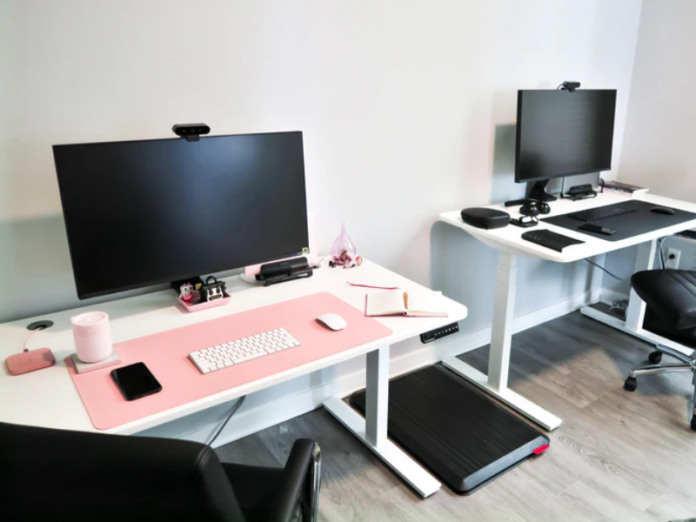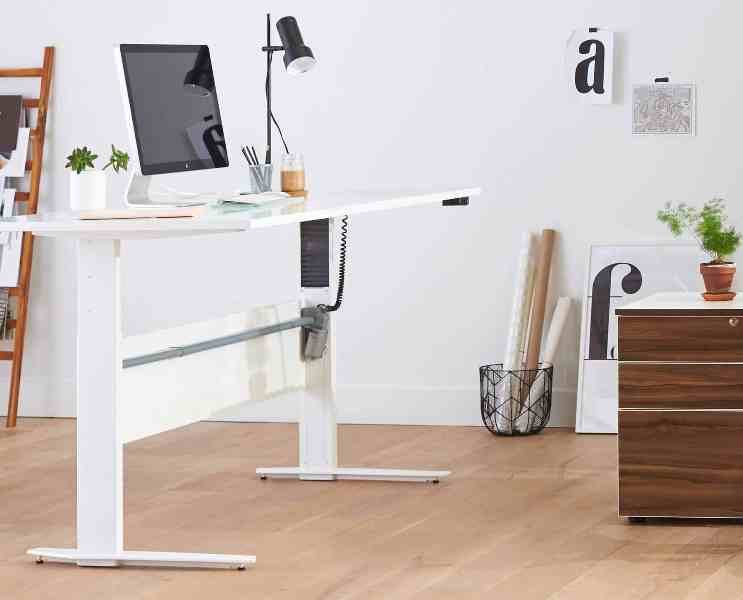If there’s one thing workplace research can agree on, it’s that sitting for too long is bad for you. Research also offers a solution. Studies have shown that switching between sitting, walking, and standing in the workplace are all vital to your health. Some evidence even suggests that staying active during the workday can improve your mood and mental health.
Here are 7 benefits of using standing desks in the workplace.
Before we dive in, let’s see what a standing desk is.
What Is a Standing Desk?
Standing desks do exactly what they say. They allow you to work at your desk standing up, rather than sitting down. You could make your own make-shift standing desk by balancing your computer and keyboard on a pile of books. Fortunately you can avoid any homemade desk disasters, because standing desks are readily available in a seemingly endless range of prices and sizes.
Portable stands can be used to convert any fixed desk into a standing workstation, and are found on the cheaper end of the spectrum. Custom-built standing desks are usually on the more expensive end of the spectrum and can be tailored to the user’s needs. Products such as the Desky single sit stand desk fall somewhere in between. It’s an excellent tool for transitioning between standing and sitting desks. Desks like these are adjustable and allow you to slowly work your way into the standing desk phenomenon.
The Benefits of Using a Standing Desk
Standing desks have become very popular in recent years. This is largely in part to the scientifically proven benefits of adjustable workstations over and over again. Here are a few of the many benefits of using standing desks in the workplace.
Boost productivity and workplace communication
Let’s start with the major benefits that standing desks offer.
Adjustable desks have been proven to improve productivity, job satisfaction, and workplace communication. A study over the course of a year found that participants who used standing desks were more active, refreshed, awake, limber and energetic. An estimated 61% of participants found an improvement in quality of life not only in the workplace, but also in their personal life.
The study also found that these workstations may also have social and mental health benefits
Reduce back pain
In the US the average office worker sits for 15 hours each day. Too much sitting can counterbalance the benefits of exercise and poor posture while sitting can lead to premature disc degeneration.
Reducing the time spent sitting by 66 minutes a day can reduce upper back and neck pain by more than 50% and can even lead to improved mood after 4 weeks. The study also found that removing the stand up desk negated all of the observed improvements within just two weeks.
Improve cardiovascular health
Society has been researching the benefits of standing for a long time.
More recently in 2013, a comparison of 18 studies with a combined total of 800,000 participants all agreed that a sedentary lifestyle leads to a 90% increase in the risk of cardiovascular mortality and a 147% increase in the risk of cardiovascular events compared to an active lifestyle. If you want to maintain good cardiovascular health you need to stand up and move around during the workday.
Lowers blood sugar levels
Too much time spent being still time has been linked to greater risk of type 2 diabetes.
A UK-based study of 10 office workers found that standing for 3 hours after lunch reduced the blood-sugar spike by over 40% compared to that of sitting for the same amount of time. As a control, both groups took the same amount of steps. This indicated that the reduced spike was due to standing rather than additional movements around the office.
Another study found that shifting between standing and sitting every 30 minutes throughout the workday reduced spikes by about 11% on average.
Improve memory, boost mood
A sedentary lifestyle, caused by sitting in the office for too long, has also been shown to increase the risk of depression and anxiety. It is interesting how standing up throughout the workday can improve mood, boost energy, and alleviate this problem.
In 2011, a 4-week study researched the impact of using standing desks on 24 office workers. At the end, participants were asked a series of questions regarding the specific benefits of sitting vs standing positions and visa versa.
Participants using stand-up desks reported less stress and fatigue compared to those who sat for the entire workday. They also reported increased energy and motivation, felt more focused, felt more productive, and after returning to their old seated desks, overall moods reverted to their original levels.
The research is clear. Height-adjustable desks are the best and play an important role in workplace designs that fosters employee well-being. They are not just for home offices. Speak to an HR consultant in your workplace about getting them in your office.




















